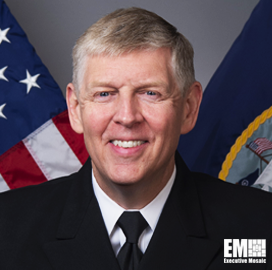Rear Adm. Lorin Selby asserts that the U.S. Navy is positioned at a unique moment in history, a crucial turning point where technology is moving at a “breakneck pace” and many sectors, including the military, have arrived at a decisive fulcrum between the analog and the digital.
“This is a win or lose decade. If we don’t turn the tide, capture some of these technologies for our advantage, find ways to utilize them for influence…we are going to have trouble this century,” the chief of naval research told a GovCon audience during his closing keynote at the 2022 Potomac Officers Club’s Annual Navy Summit in Virginia.
Selby highlighted the efforts of the Naval Research Establishment, which includes the U.S. Naval Research Laboratory, NAVSEA, NAVAIR, the Office of Naval Research, academic entities and several others, as leading the charge in developing new strategies and approaches that can assist in keeping adversaries “off balance,” which Selby said is the consistent goal.
Some of these adversaries, the naval research chief said, are terrorists and bad actors in China, Russia, Iran and North Korea. But he was also sure to mention that he foresees challenges such as droughts, climate crises and food shortages as significant threats with which the Department of Defense and government agencies more broadly will be faced with over the coming years.
According to Selby, these impediments could lead to mass migrations as well as “additional outbursts or conflicts.”
During his speech, the rear admiral wondered whether the current arsenal of battleships and Navy fleet enforcements are sufficient to address the problems incurred by new technological advancements or developments such as the creation of manmade islands or “immobile aircraft carriers” in the middle of the South China Sea.
“I’m not here to suggest this is not a credible force,” Selby said of the Navy’s armada. “It is a credible force. I’m just wondering if it is enough and I contend that it’s not; I contend that we need a backup plan or a hedge strategy.”
A key element of the backup strategy invoked by Selby is the SCOUT Experimentation effort, which is a program dedicated to solving warfighters’ conundrums and meeting combat needs with evolving technologies, especially artificial intelligence, unmanned and automated strategies.
Selby emphasized that the technological solutions being tested by SCOUT were not solely of the unmanned variety, however, but also focused on “changing the mindset from a very large platform-centric capability, like a ship, submarine, aircraft carrier and thinking more about distributable technologies that are smaller” — or, what has been dubbed, “the small, the agile and the many.”
He described SCOUT’s approach as highly collaborative, an exchange of ideas between scientists, engineers and academics alongside combat people. He welcomed the input of the many government contracting industry members in the room to seek an active role in the research endeavor.
“The other thing about innovation is, it’s not just about inventing new stuff. It’s also about combining ideas,” Selby commented.

If you are intrigued by the technological future of not just the Navy but also other service branches, such as the U.S. Army, be sure to attend GovCon Wire’s 2nd Annual Army IT and Digital Transformation Forum, taking place digitally on June 15.
Raj Iyer, chief information officer of the Army, will deliver the keynote address. Click here to register for the event.




